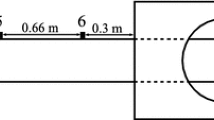Abstract
While a CFD simulation of the flow in overexpanded planar nozzles shows, inside an ideal nozzle, the existence of a hysteresis process in the transition from regular to Mach and from Mach to regular reflections such a process does not appear in tapered nozzles. Previous simulations have dealt only with the flow outside the nozzle and thus concluded that the hysteresis phenomenon takes place outside the nozzle even when viscous effects were introduced. When including the geometry of the nozzle in the simulation it becomes evident that flow separation will occur before transition from regular to Mach reflection for all relevant flow Mach numbers. The simulation reveals complex changes in the flow structure as the ratio between the ambient and the stagnation pressures is increased and decreased. The pressure along the nozzle wall downstream of the separation point was found to be less than the ambient pressure with the effect being more pronounced in the case of the ideal nozzle. The present study complements a previous study that dealt only with flow separation in an ideal nozzle.
Similar content being viewed by others
References
Hadjadj A.: Numerical investigation of shock reflection phenomena in overexpanded supersonic jets. AIAA J. 42(3), 570–577 (2004)
Li H., Ben-Dor G.: A parametric study of mach reflection in steady flows. J. Fluid Mech. 341, 101–125 (1997)
Schotz M., Levy A., Ben-Dor G. et al.: Analytical prediction of the wave configuration size in steady flow mach reflections. Shock Waves 7(6), 363–372 (1997)
Vuillon J., Zeitoun D., Ben-Dor G.: Reconsideration of oblique shock wave reflections in steady flows. Part 2. Numerical investigation. J. Fluid Mech. 301, 37–50 (1995)
Chpoun A., Passerel D., Li H. et al.: Reconsideration of oblique shock wave reflections in steady flows. Part 1. Experimental investigation. J. Fluid Mech. 301, 19–35 (1995)
Ivanov M.S., Vandromme D., Fomin V.M. et al.: Transition between regular and mach reflection of shock waves: new numerical and experimental results. Shock Waves 11, 99–107 (2001)
Hornung H.G., Oertel H., Sandeman R.J.: Transition to mach reflection of shock waves in steady and pseudosteady flow with and without relaxation. J. Fluid Mech. 90, 541–560 (1979)
Kudryavtsev, A.N., Khotyanovsky, D.V., Hadjadj, A.: Numerical investigation of shock wave interactions in supersonic imperfectly expanded jets. In: International Conference on Methods of Aerophysical Research, vol. III, pp. 138–143 (2002)
Ralov A.I.: On the impossibility of regular reflection of a steady-state shock wave from the axis of symmetry. J. Appl. Math. Mech 54(2), 200–203 (1990)
Welsh, F.P.: Electron beam fluorescence measurements of shock reflection hysteresis in an under-expanded supersonic jet. In: 21st International Symposium on Shock Waves, Paper 5950 (1997)
Gribben B.J.: Numerical study of shock reflection hysteresis in an underexpanded jet. AIAA J. 38(2), 275–283 (2000)
Shimshi E., Ben-Dor G., Levy A.: Viscous simulation of shock-reflection hysteresis in overexpanded planar nozzles. J. Fluid Mech. 635(1), 189–206 (2009)
von-Neumann J.: Oblique reflection of shocks. In: Taub, A.H. (eds) John von Neumann Collected Works. Vol. VI., pp. 238–299. Pergamon Press Ltd, Oxford (1943)
McCabe, A.: Design of a supersonic nozzle. Aeronautical Research Council, 3440 (1964)
Zorina I.S., Kurshakov M.Y., Chirkov N.V.: Design of universal supersonic nozzles with conical flow. Fluid Dyn. 24(4), 649–652 (1990)
Reshotko, E., Tucker, M.: Effect of a discontinuity on turbulent boundary-layer-thickness parameters with application to shock-induced separation. NACA, TN 3454 (1955)
Morrisette, E.L., Goldberg, T.J.: Turbulent-flow separation criteria for overexpanded supersonic nozzles. NASA Langley Research Center, NASA-TP-1207 (1978)
Romine G.L.: Nozzle flow separation. AIAA J. 36(9), 1618–1625 (1998)
Nasuti, F., Onofri, M., Pietropaoli, E.: The influence of nozzle shape on the shock structure in separated slows. In: Proceedings of the 5th European Symposium on Aerothermodynamics for Space Vehicles, pp. 353–358 (2004)
Hadjadj A., Onofri M.: Nozzle flow separation. Shock Waves 19(3), 163–169 (2009)
Hunter, C.A.: Experimental, theoretical, and computational investigation of separated nozzle flows. In: 34th AIAA/ASME/SAE/ ASEE Joint Propulsion Conference and Exhibit (1998)
Frey, M.: Investigation of flow problems in rocket nozzles at overexpansion. PhD Thesis, Institute of Aerodynamics and Gasdynamics, University of Stuttgart, Stuttgart (2001)
Stark, R.H.: Flow separation in rocket nozzles, a simple criteria. In: 41st AIAA/ASME/SAE/ASEE Joint Propulsion Conference and Exhibit (2005)
Stark, R.H., Hagemann, G.: Current status of numerical flow prediction for separated nozzle flows. In: 2nd European Conference on Aerospace Science (2007)
Menter F.R.: Two-equation eddy-viscosity turbulence models for engineering applications. AIAA J. 32(8), 1598–1605 (1994)
Mulvany, N.J., Chen, L., Tu, J.Y.: Steady-state evaluation of two-equation RANS (Reynolds-averaged Navier–Stokes) turbulence models for high-Reynolds number hydrodynamic flow simulations. DSTO Platform Sciences Laboratory, DSTO-TR-1564 (2004)
Speziale C.G., Thangam S.: Analysis of an RNG based turbulence model for separated flows. Int. J. Eng. Sci. 30(10), 1379–1388 (1992)
Nasuti F., Onofri M.: Shock structure in separated nozzle flows. Shock Waves 19(3), 229–237 (2009)
Author information
Authors and Affiliations
Corresponding author
Additional information
Communicated by H. Kleine.
This paper was based on work that was presented at the 27th International Symposium on Shock Waves, St. Petersburg, Russia, July 19–24, 2009.
Rights and permissions
About this article
Cite this article
Shimshi, E., Ben-Dor, G. & Levy, A. Viscous simulation of shock reflection hysteresis in ideal and tapered overexpanded planar nozzles. Shock Waves 21, 205–214 (2011). https://doi.org/10.1007/s00193-011-0325-z
Received:
Revised:
Accepted:
Published:
Issue Date:
DOI: https://doi.org/10.1007/s00193-011-0325-z




